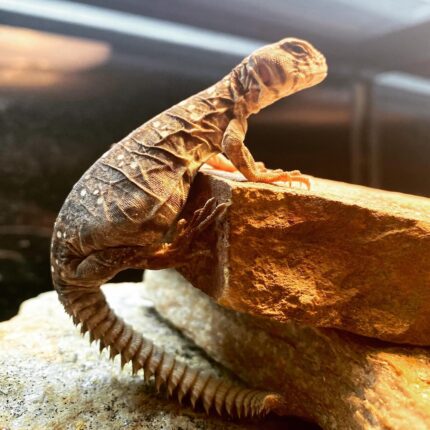

Helmeted Gecko
$220.00 / 0.00262 Ƀ
Tarentola chazalia
The Helmeted Geckos is a small nocturnal species found in rocky deserts of Morocco. This species is quite hard to find within the pet trade.
| Origin | Morocco |
|---|---|
| Environment | Rocky Deserts and Shrublands |
| Adult Size | 4inches |
| Suitability | Novice |
| Lifespan | 8 Years + |
| Temperament | Skittish |
Helmeted geckos are small and hardy and make excellent pets! When provided a little extra humidity, they thrive in captivity.
NAME
Given the large scales at the back of their head, it’s easy to see where helmeted geckos (Tarentola chazaliae) got their common name. These small geckos live near the coast of northwestern Africa, including Western Sahara, Mauritania, and Morocco.
COLORATION
Helmeted geckos come in greys, browns, or orange colors. Some individuals have no pattern, while others can have irregular light or dark spots. They are characterized by rough scales across their body, which extend into small spikes along the length of their tail.
HOUSING
A 10 gallon tank can house two or three adult helmeted geckos. Sand, such as Repti-Sand, works well as a substrate provided that it is regularly spot cleaned. We house our animals on BioBedding Desert. So long as the animals are kept healthy and temperatures are correct, impaction is not a risk.
Helmeted geckos are nocturnal and will spend the day hiding beneath cage items. Cork bark, upside down plant saucers, slate, and other similar items can be used as hides; commercially available reptile hides also work. Additional cage items, such as rocks or low driftwood, can be provided as decor and climbing material. However, it is important to make sure that any heavy cage items are supported directly by the bottom of the enclosure and not simply placed on top of the sand.
TEMPERATURE AND HUMIDITY
This species should be kept at an ambient temperature between 75-85F. A daytime hot spot of around 95F should also be provided; this can be maintained with a heat pad or heat lamp. Helmeted geckos species requires no special lighting.
Helmeted geckos differ from other desert geckos in their humidity requirements. Because they live near the coast, they have adapted to live in more humid environments. Ambient humidity can range from 40-60% for this species, but they will thrive given more frequent misting, around once or twice daily. The enclosure should have enough ventilation such that it dries out within a few hours of misting. Additionally, a humid hide should be provided so that a humid microclimate is always available within the enclosure. Both temperature and humidity can be monitored with a thermometer/hygrometer.
SIZE
Helmeted geckos are a small species, with adult males reaching 2-3 inches and adult females reaching 3-4 inches in length.
DIET
Helmeted geckos should be fed an insectivorous diet. Dubia roaches or crickets should be offered as a staple, with other food items (such as small mealworms or waxworms) being occasionally offered as treats. A good rule of thumb for size is to only offer insects whose length does not exceed the space in between the gecko’s eyes. Generally, hatchling helmeted geckos should be fed insects measuring around ⅛-inch, with subadults and adults being moved up to ¼-inch insects. Feeder insects should be dusted with a vitamin/mineral supplement. An escape-proof feeding bowl will minimize the number of bugs that escape and hide around the enclosure.
SEX
Helmeted geckos are not difficult to sex; males will have bulges at the base of their tail. As adults, males are generally smaller than females.
BREEDING
A brumation period in the winter is recommended to incite breeding. Females will lay pairs of eggs, which can be carefully removed and incubated.











